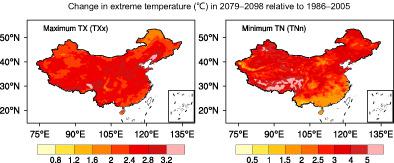当前位置:
X-MOL 学术
›
Int. J. Climatol.
›
论文详情
Our official English website, www.x-mol.net, welcomes your
feedback! (Note: you will need to create a separate account there.)
Evaluation and ensemble projection of extreme high and low temperature events in China from four dynamical downscaling simulations
International Journal of Climatology ( IF 3.5 ) Pub Date : 2020-07-25 , DOI: 10.1002/joc.6765 Donglin Guo 1, 2 , Ying Zhang 1, 2, 3 , Xuejie Gao 3 , Nick Pepin 4 , Jianqi Sun 1
International Journal of Climatology ( IF 3.5 ) Pub Date : 2020-07-25 , DOI: 10.1002/joc.6765 Donglin Guo 1, 2 , Ying Zhang 1, 2, 3 , Xuejie Gao 3 , Nick Pepin 4 , Jianqi Sun 1
Affiliation

|
Extreme climate events are often of great interest because of their close relationship with meteorological and hydrological disasters. In this study, four RCM simulations driven by different GCMs (CSIRO‐Mk3.6.0, EC‐EARTH, HadGEM2‐ES, and MPI‐ESM‐MR) are used as an ensemble to project changes in extreme high and low temperatures in China as represented by selected Expert Team on Climate Change Detection indices. Each simulation is performed at 25 km resolution from 1980 to 2099 using RegCM4.4 RCM. Results show the following: (a) All four reasonably reproduce climatological maximum daily maximum temperature (TX), warm spell duration, minimum daily minimum temperature (TN), and cold spell duration, but the majority shows relatively weak ability to capture climatological warm day and cold night frequencies. (b) Although the RCM homogenizes much of the variance originally shown between driving GCM simulations, marked dissimilarities are still shown in western China across the four downscaling simulations, implying a dependency on the individual GCM‐driven RCM simulation for this region. (c) All of China shows an increase in maximum TX, warm days, warm spell duration, minimum TN, and a decrease in cold nights and cold spell duration, during the near‐term, middle‐term, and long‐term. The Tibetan Plateau and its adjacent regions show more significant changes in extreme temperature, indicating stronger sensitivity to changes in extremes. RCM downscaling projects less significant change in extreme temperatures than the driving GCM. (d) The ensemble of RCM simulations projects that area‐averaged maximum TX, warm days, warm spell duration, and minimum TN increase over China as a whole by 2.5°C, 21.1%, 43.6 days, and 3.3°C, respectively, while cold nights and cold spell duration decrease by 6.8% and 2.0 days, respectively during the long‐term under the RCP4.5 scenario relative to 1986–2005. Future episodes of extreme high temperature are likely to require more research as they become more common.
更新日期:2020-07-25











































 京公网安备 11010802027423号
京公网安备 11010802027423号